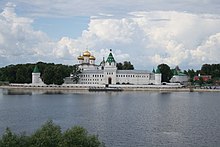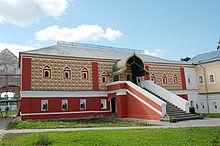Ipatios monastery
The Ipatios Monastery of the Holy Trinity ( Russian Свято-Троицкий Ипатьевский монастырь ) is located in the Russian city of Kostroma , on its northern edge, directly at the mouth of the Kostroma River into the Volga . Today it is a Russian Orthodox male monastery, which is one of the most important sights of the so-called Golden Ring due to its historical importance and development .
history
The Ipatios Monastery of Kostroma was first mentioned in a document from 1432. However, it is believed that it was founded about a century earlier. The monastery is said to have been founded by a Tatar prince in memory of an alleged miracle healing. According to legend, the founder converted to Christianity and served at the court of the Moscow Grand Duke Ivan Kalita . He is also said to have been an ancestor of the boyar family of the Godunovs, which is why the Ipatios Monastery became very rich through generous donations from the Tsar's court in the late 16th century and during the reign of Tsar Boris Godunov . The original wooden structures including the central church of the monastery - the Holy Trinity Cathedral - gave way in the 16th century to the stone ensemble, which has been partially preserved to this day. In addition, the monastery was given a new fortification wall with watchtowers based on the model of an old Russian Kremlin .

The Ipatios monastery also experienced its greatest historical importance at the end of the 16th and beginning of the 17th century. Michael Fjodorowitsch Romanow , later the first Russian tsar from the Romanov dynasty, lived in exile in a hermitage of the Ipatios monastery in the 1580s. With the fall of the Godunovs after Boris' death and during the so-called Time of Troubles , the Romanovs received the monastery territories at their disposal. When the future tsar was exposed to mortal danger from Polish-Lithuanian invaders in 1613 , he and his family fled behind the walls of the Ipatios monastery. With Russia's victory over the invaders, Michael Romanov was made tsar in February 1613, precisely in the Ipatios Monastery. This fact gave the monastery even more fame and prosperity in the decades that followed, because the Ipatios Monastery was in a way the cradle of the Romanov dynasty ever since. As early as the 1640s, the monastery grounds were expanded to include the Klausen of the so-called New City , which connects to the north of the Old City , i.e. the existing monastery grounds. In addition, the Holy Trinity Cathedral from the Godunov era, which was destroyed in a powder explosion, was replaced by the current building between 1650 and 1652.
Well into the 18th century, the Ipatios Monastery was considered one of the most famous and richest in Russia. It was only with the expropriation of the Russian Orthodox Church in 1764 that the monastery lost a large part of its properties and then gradually lost its importance. Nonetheless, it was highly revered by the Romanov House until its demise: it was a duty for each of the Russian tsars and emperors to visit the monastery at least once.
When the Communists came to power after the October Revolution in 1917 , the Ipatios Monastery shared the fate of other Russian Orthodox monasteries: in 1919 it was closed and the properties confiscated. From 1932 to 1934, the Church of the Nativity of the Virgin in the Ipatios Monastery, which was built in the 1860s by the famous architect Konstantin Thon , was demolished . From the 1950s the ensemble of the Ipatios monastery was extensively restored, and since then it has had museum status. In the early 1990s, the monastery was returned to the church and is now used as both a monastery and a museum. The latter is well known and has been visited by all three previous presidents of Russia during their term of office (most recently by Dmitri Medvedev on May 15, 2008).
Buildings
The ensemble of the monastery, which is enclosed by up to ten meters high walls with a total of ten towers, is divided into the so-called Old Town ( Старый город ) and New Town ( Новый город ). The former is considered to be the centerpiece of the monastery and was essentially built in the late 16th century, during the heyday of the Godunow house. The most striking monastery buildings are also located there, including the Trinity Cathedral. The New City, which is roughly the same size, was built in the middle of the 17th century and mainly contains monk's clauses and administrative buildings.
The central element in the monastery ensemble is the Trinity Cathedral ( Троицкий собор ). It was built in its current form in the years 1650–1652 and has a neat shape with a traditional five-piece composition of onion domes and the parade entrance in the form of a staircase gallery with a tent roof . The elaborate fresco paintings inside the cathedral gradually emerged during the second half of the 17th century. They consist of a total of 81 compositions, which are dedicated to various biblical themes, and on the supporting columns there are portraits of Russian rulers, including the first from the Romanov family , who was elected Tsar in the Ipatios Monastery. The five-tier iconostasis from the 1750s is also worth seeing inside the cathedral .
Immediately to the right of the Trinity Cathedral is the bell tower built at the beginning of the 17th century under Boris Godunov. It was rebuilt several times over the centuries and received its pointed tent roof in the years 1645–1646. The simple two-story building just behind the bell tower is the so-called candle house ( Свечной корпус ). It was built in the middle of the 19th century based on a design by Konstantin Thons and originally served as a production facility for candles. Today, expositions from the former sacristy of the monastery (including historical icons, books and church utensils) are housed on both floors of the house.
To the northeast, the ensemble of the Old City is completed by the very solemn-looking Romanov Palace ( Палаты бояр Романовых ). It was built as a residential building at the end of the 16th century and was used by the Romanov family as accommodation during the Polish invasion in 1613. The building is executed in a very traditional, old Russian style and with its characteristic facade is somewhat reminiscent of the Faceted Palace in the Moscow Kremlin . Inside, the interior of a residential residence from the early 17th century has been recreated relatively true to the original.
literature
- EVKudrjašov: Architekturnye pamjatniki Ipatʹevskogo monastyrja XVI-XVII vv. Kraevedčeskie zapiski KIAMZ, vyp.1, Jaroslawl 1973, pp. 62–86
Web links
- Official website of the monastery (Russian)
- Ipatios Monastery on kostroma-online.ru (Russian)
Coordinates: 57 ° 46 '38.6 " N , 40 ° 53' 34.3" E


